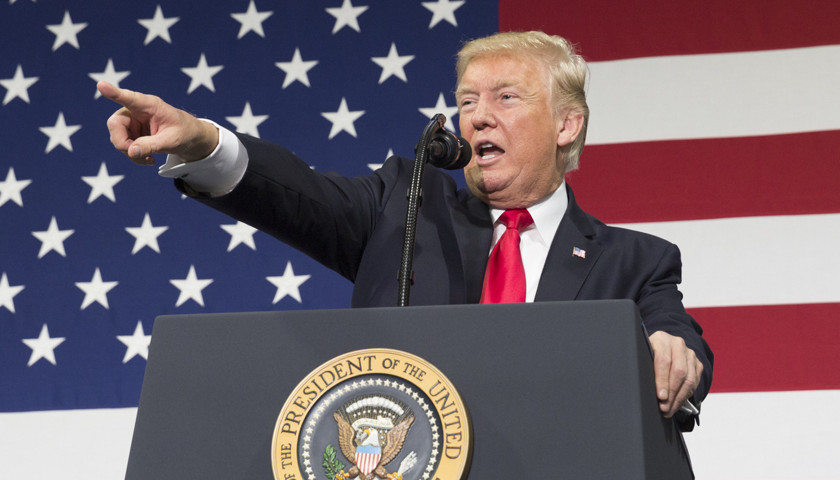by Robert Romano
[Click here to urge Congress to build the wall!]
There won’t be any vote on wall funding this year or any year at the rate we’re going — because nobody in Congressional leadership is apparently willing to stick it in a bill and simply vote on it. Even to defeat it.
Until the end of the year, Republicans are in complete control of the House of Representatives. Under the leadership of House Speaker Paul Ryan (R-Wis.) and House Majority Leader Kevin McCarthy (R-Calif.), however, the only vote on any wall funding that occurred did not happen until the March 2018 omnibus spending bill.
And then, it was just the measly $1.6 billion supplement that President Donald Trump had requested — in Feb. 2017 — that was intended to be attached to the FY 2017 spending bill that was still being resolved in the early days of the Trump administration. Instead, it took more than a year to get done.
Even now, to date, House Republicans have not even had a show-vote on a messaging bill that McCarthy promised to fully fund the wall — even though such a vote would be practically meaningless.
The House has not even sent a spending bill with the wall to the Senate to be filibustered. There were plenty of opportunities. There was FY 2017 funding that was wrapped up in early 2017. There was FY 2018 funding that was addressed in the Sept. 2017 continuing resolution, and then the year-end omnibus. And then FY 2019 funding, that was addressed in the Sept. 2018 continuing resolution. There was a debt ceiling bill. There were budget reconciliation bills.
Republicans in Congress did not even try to put it up to fail. They just failed to bring it up. Now what?
If at the end of the day as appears likely, Congress once again does not produce a spending bill that includes wall funding — right now the White House is demanding $5 billion for construction but it appears the only consensus on Capitol Hill is to kick the can via a short-term funding bill — then President Trump still has one card to play.
And that is to veto the spending bill and force Congress to vote on overriding it. A vote to sustain the veto is a vote for the wall, and a vote to override the veto is a vote against the wall.
Then, to get the wall, Trump doesn’t need 218 votes in the House, he needs 146. And he doesn’t need 60 votes in the Senate, he needs 34. That’s what the separation of powers provides for.
President Ronald Reagan got tax cuts and defense spending increases by blocking spending bills, resulting in a total of eight partial government shutdowns.
And he had the votes to sustain vetoes when he needed. In 1983, 146 House members signed a letter saying they would vote to sustain presidential vetoes on funding bills.
In the end, there may be no other way to force a vote on the wall that means anything — or anything else. Yes, that would technically result in a partial government shutdown, but to get there a line in the sand has to be drawn. On Dec. 11 in the Oval Office, President Trump declared, “If we don’t have border security, we’ll shut down the government. This country needs border security… The wall is a part of border security.”
Now Trump has to follow through. With the border being flooded with the migrant caravan and drugs and gangs continuing to pour in, and in the meantime, lives continue to be lost in human trafficking, there must be a deterrent to making the journey in the first place. The border needs to be secured, and the wall is a part of that.
Looking forward, the path does not get any easier, with Nancy Pelosi poised to take over as House Speaker in January. And she has all already declared she will never fund it.
The Senate takes 60 votes to get anything done there, and Senate Minority Leader Chuck Schumer (D-N.Y.) has sworn no votes for the wall from Senate Democrats, and unwilling to nuke the filibuster, Senate Majority Leader Mitch McConnell (R-Ky.) is left perpetually shy of the votes he needs to pursue any item, let alone the wall.
Under regular order, with the GOP in charge of the House and Senate, or just the Senate, as the case will be next year, there is no probable path for the wall. The Washington, D.C. establishment will not allow it.
That is, unless Trump vetoes the spending bill, not just now, but in 2019 when this carries over into next year and then puts it up for a vote. Let the House and Senate Republicans vote to sustain that veto — and fight. To get the wall built, Trump has to prove he has the leverage and the votes to stop the spending bill so there can be a real negotiation.
And it’s not just the wall, it’s anything on appropriations. Infrastructure. 5G. Defense spending. Health care. You name it, if the President is ever going to have a say he has to prevent Congress from imposing its will on the American people.
Even former President Barack Obama had a credible veto threat. His people got to write the spending bills, or at least obtain provisions the administration considered top priority.
On the other hand, if the House and Senate have de facto bipartisan supermajorities, they’ll win every time. Elections will be of no consequence, because the true ruling party in Congress will continue to be bipartisan.
On Twitter today, the President declared, “In our Country, so much money has been poured down the drain, for so many years, but when it comes to Border Security and the Military, the Democrats fight to the death. We won on the Military, which is being completely rebuilt. One way or the other, we will win on the Wall!”
For Trump to win on the wall, or any president for that matter to win his political program, it’s time for the art of the veto. And then we’ll see how Congress votes. This is one where the President needs to fight.
– – –
Robert Romano is the Vice President of Public Policy at Americans for Limited Government.




